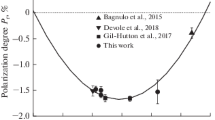Abstract
Results of polarimetric observations of a high-albedo asteroid 64 Angelina obtained in the phase-angle range from 0.8° to 24.3° are presented. The observations were carried out in the period from September 28 to October 9, 2008, and on November 15, 2011, and September 18, 2012, with the 1.25-m and 2.6-m telescopes of the Crimean Astrophysical Observatory equipped with a five-color double-beam photopolarimeter and a single-channel photometer-polarimeter, respectively. Our observations confirm the polarimetric opposition effect in asteroid 64 Angelina at small phase angles and well agree with the other observations. The obtained results are discussed in terms of the currently available models of the light scattering by regolith surfaces.
Similar content being viewed by others
References
A. V. Berdyugin and N. M. Shakhovskoi, “The technique for simultaneous measurements of four Stokes parameters in the UBVRI bands,” Izv. Krym. Astrofiz. Obs. 87, 122–134 (1993).
N. M. Shakhovskoi and Yu. S. Efimov, “Polarization observations of nonstationary stars and extragalactic objects. I. The instruments and technique for observations and their processing,” Izv. Krym. Astrofiz. Obs. 45, 90–110 (1972).
Yu. G. Shkuratov, “The diffraction mechanism of the opposition effect of brightness of the complex-structure surfaces,” Kin. Fiz. Nebes. Tel 4(5), 33–38 (1988).
I. N. Belskaya, N. N. Kiselev, Yu. N. Krugly, et al., “Opposition polarimetry and photometry of S and E-type asteroids,” Icarus 166(2), 276–284 (2003).
T. H. Burbine, E. A. Cloutis, S. F. Bus, et al., “The detection of troilite (FeS) on the surfaces of E-class asteroids,” Bull. Am. Astron. Soc. 30, 1025 (1998).
B. E. Clark, S. J. Bus, A. S. Rivkin, et al., “E-type asteroid spectroscopy and compositional modeling,” J. Geophys. Res. 109(E2), E02001 (2004).
J. Durech, M. Kaasalainen, D. Herald, et al., “Combining asteroid models derived by lightcurve inversion with asteroidal occultation silhouettes,” Icarus 214(2), 652–670 (2011).
S. Fornasier, A. Mogliorini, E. Dotto, and M. A. Barucci, “Visible and near infrared spectroscopic investigation of E-type asteroids, including 2867 Steins, a target of the Rosetta Mission,” Icarus 196(1), 119–134 (2008).
M. J. Gaffey and M. S. Kelley, “Mineralogical variations among high E-type asteroids: Implications for asteroid igneous processes,” in Proc. Lunar and Planet. Sci. Conf. XXXV, League City, 2004 (League City, Texas, 2004), abstract 1812.
A. W. Harris, J. W. Young, L. Contreiras et al., “Phase relations of high albedo asteroids: The unusual opposition brightening of 44 Nysa and 64 Angelina,” Icarus 81(2), 365–374 (1989).
J. -C. Hsu and M. Breger, “On standard polarized stars,” Astrophys. J. 262(1), 732–738 (1982).
N. N. Kiselev, N. M. Shakhovskoj, and Yu. S. Efimov, “On the polarization opposition effect of E-type asteroid 64 Angelina,” Icarus 120(2), 408–411 (1996).
K. Lumme and K. Muinonen, “A two-parameters system for linear polarization of some Solar System objects,” in Asteroids, Comets, Meteors, Ed. by A. W. Harris and E. Bowell (Lunar and Planet. Inst., Houston, 1993), pp. 194–197.
M. I. Mishchenko, “On the nature of the polarization opposition effect exhibited by Saturn’s rings,” Astrophys. J. 411(1), 351–361 (1993).
M. I. Mishchenko and J. M. Dlugach, “Coherent backscatter and the opposition effect for E-type asteroids,” Planet. Space Sci. 41(3), 173–181 (1993).
M. I. Mishchenko, V. K. Rosenbush, and N. N. Kiselev, “Weak localization of electromagnetic waves and opposition phenomena exhibited by high-albedo atmosphereless Solar System objects,” Appl. Opt. 45(8), 4459–4463 (2006).
V. Piirola, “A double image chopping polarimeter,” Astron. Astrophys. 27, 383–388 (1973).
V. Piirola, “Simultaneous five-color (UBVRI) photopolarimeter,” in Radiation of Circumstellar Origin, Ed. by G. V. Coyne, A. M. Magalhaes, A. F. Moffat, R. E. Schulte-Ladbeck, and S. Tapia (Vatican Observatory, Vatican City State, 1988), pp. 735–746.
M. Poutanen, “UBV photometry of asteroid 64 Angelina,” in Asteroids, Comets, Meteors, Ed. by C. I. Lagerkvist and H. Rickman (Universitet Reprocentralen, Uppsala, 1983), pp. 45–48.
V. K. Rosenbush, N. N. Koselev, V. G. Shevchenko, et al., “Polarization and brightness opposition effects for the E-type asteroid 64 Angelina,” Icarus 178(2), 222–234 (2005).
V. K. Rosenbush, V. G. Shevchenko, N. N. Kiselev, et al., “Polarization and brightness opposition effects for the E-type asteroid 44 Nysa,” Icarus 201(2), 655–665 (2009).
K. Serkowski, “Polarimeters for optical astronomy,” in Planets, Stars, and Nebulae Studied with Photopolarimetry, Ed. by T. Gehrels, (Univ. Arizona Press, Tucson, 1974), pp. 135–174.
M. K. Shepard, A. W. Harris, P. A. Taylor, et al., “Radar observations of asteroids 64 Angelina and 69 Hesperia,” Icarus 215(2), 547–551 (2011).
V. G. Shevchenko and E. F. Tedesco, “Asteroid albedos deduced from stellar occultations,” Icarus 184(1), 211–220 (2006).
E. F. Tedesco, J. G. Williams, D. L. Matson, et al., “Three-parameter asteroid taxonomic classifications,” in Asteroids II, Ed. by R. P. Binzel, T. Gehrels, and M. S. Matthews (Univ. Arizona Press, Tucson, 1989), pp. 1151–1161.
D. J. Tholen, “Asteroid taxonomic classification,” in Asteroids II, Ed. by R. P. Binzel, T. Gehrels, and M. S. Matthews (Univ. Arizona Press, Tucson, 1989), pp. 1139–1150.
B. Zellner, T. Gehrels, and J. Gradie, “Minor planets and related objects. XVI. Polarimetric diameters,” Astron. J., 1100–1110 (1974).
B. Zellner and J. Gradie, “Minor planets and related objects. XX. Polarimetric evidence for the albedos and compositions of 94 asteroids,” Astron. J. 81, 262–280 (1976).
Author information
Authors and Affiliations
Corresponding author
Additional information
Original Russian Text © S.V. Zaitsev, N.N. Kiselev, V.K. Rosenbush, S.V. Kolesnikov, K.A. Antonyuk, 2014, published in Kinematika i Fizika Nebesnykh Tel, 2014, Vol. 30, No. 3, pp. 71–80.
About this article
Cite this article
Zaitsev, S.V., Kiselev, N.N., Rosenbush, V.K. et al. Polarimetry of the E-type asteroid 64 Angelina. Kinemat. Phys. Celest. Bodies 30, 155–160 (2014). https://doi.org/10.3103/S0884591314030064
Received:
Published:
Issue Date:
DOI: https://doi.org/10.3103/S0884591314030064



